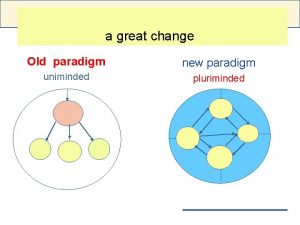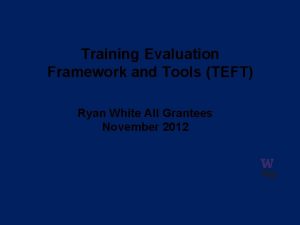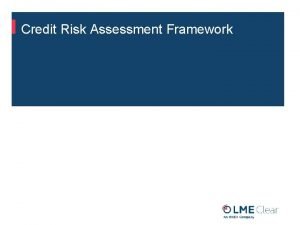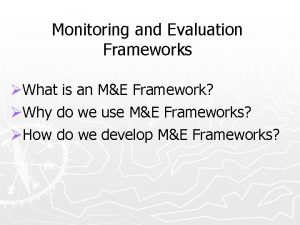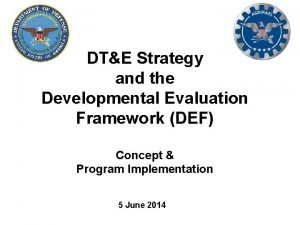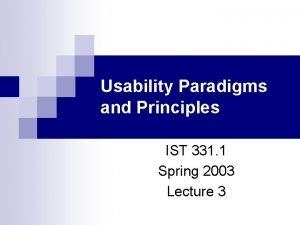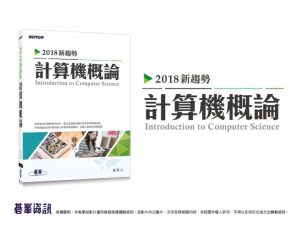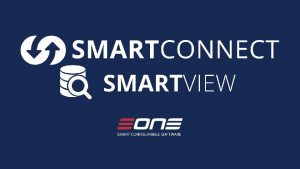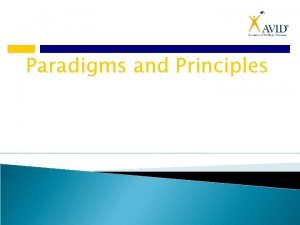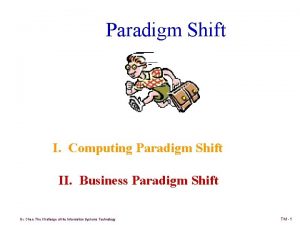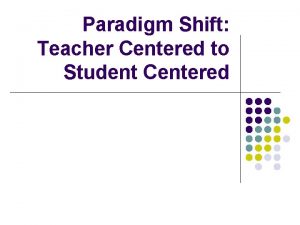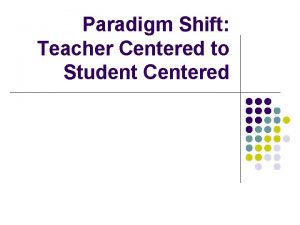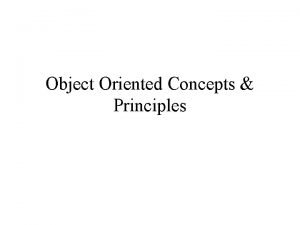An evaluation framework Evaluation paradigm Any kind of


















- Slides: 18

An evaluation framework

Evaluation paradigm Any kind of evaluation is guided explicitly or implicitly by a set of beliefs, which are often under-pined by theory. These beliefs and the methods associated with them are known as an ‘evaluation paradigm’

User studies involve looking at how people behave in their natural environments, or in the laboratory, both with old technologies and with new ones.

Four evaluation paradigms • • ‘quick and dirty’ usability testing field studies predictive evaluation

Quick and dirty • ‘quick & dirty’ evaluation describes the common practice in which designers informally get feedback from users or consultants to confirm that their ideas are in-line with users’ needs and are liked. • Quick & dirty evaluations are done any time. • The emphasis is on fast input to the design process rather than carefully documented findings.

Usability testing • Usability testing involves recording typical users’ performance on typical tasks in controlled settings. Field observations may also be used. • As the users perform these tasks they are watched & recorded on video & their key presses are logged. • This data is used to calculate performance times, identify errors & help explain why the users did what they did. • User satisfaction questionnaires & interviews are used to elicit users’ opinions.

Field studies • Field studies are done in natural settings • The aim is to understand what users do naturally and how technology impacts them. • In product design field studies can be used to: - identify opportunities for new technology - determine design requirements - decide how best to introduce new technology - evaluate technology in use.

Predictive evaluation • Experts apply their knowledge of typical users, often guided by heuristics, to predict usability problems. • Another approach involves theoretically based models. • A key feature of predictive evaluation is that users need not be present • Relatively quick & inexpensive

Overview of Techniques · observing users, · asking users’ their opinions, · asking experts’ their opinions, · testing users’ performance · modeling users’ task performance

DECIDE: A framework to guide evaluation • Determine the goals the evaluation addresses. • Explore the specific questions to be answered. • Choose the evaluation paradigm and techniques to answer the questions. • Identify the practical issues. • Decide how to deal with the ethical issues. • Evaluate, interpret and present the data.

Determine the goals • What are the high-level goals of the evaluation? • Who wants it and why? • The goals influence the paradigm for the study • Some examples of goals: - Identify the best metaphor on which to base the design. Check to ensure that the final interface is consistent. Investigate how technology affects working practices. Improve the usability of an existing product.

Explore the questions • All evaluations need goals & questions to guide them so time is not wasted on ill-defined studies. • For example, the goal of finding out why many customers prefer to purchase paper airline tickets rather than e-tickets can be broken down into subquestions: - What are customers’ attitudes to these new tickets? - Are they concerned about security? - Is the interface for obtaining them poor? • What questions might you ask about the design of a cell phone?

Choose the evaluation paradigm & techniques • The evaluation paradigm strongly influences the techniques used, how data is analyzed and presented. • e. g. field studies do not involve testing or modeling

Identify practical issues For example, how to: • select users • stay on budget • staying on schedule • find evaluators • select equipment

Decide on ethical issues • Develop an informed consent form • Participants have a right to: - know the goals of the study - what will happen to the findings - privacy of personal information - not to be quoted without their agreement - leave when they wish - be treated politely

Evaluate, interpret & present data • How data is analyzed & presented depends on the paradigm and techniques used. • The following also need to be considered: - Reliability: can the study be replicated? - Validity: is it measuring what you thought? - Biases: is the process creating biases? - Scope: can the findings be generalized? - Ecological validity: is the environment of the study influencing it - e. g. Hawthorn effect

Pilot studies • A small trial run of the main study. • The aim is to make sure your plan is viable. • Pilot studies check: - that you can conduct the procedure - that interview scripts, questionnaires, experiments, etc. work appropriately • It’s worth doing several to iron out problems before doing the main study. • Ask colleagues if you can’t spare real users.

Key points · An evaluation paradigm is an approach that is influenced by particular theories and philosophies. · Five categories of techniques were identified: observing users, asking experts, user testing, modeling users. · The DECIDE framework has six parts: - Determine the overall goals - Explore the questions that satisfy the goals - Choose the paradigm and techniques - Identify the practical issues - Decide on the ethical issues - Evaluate ways to analyze & present data · Do a pilot study
 Old paradigm
Old paradigm There are some pasta
There are some pasta Any to any connectivity
Any to any connectivity Any question atau any questions
Any question atau any questions Dispositional framework vs regulatory framework
Dispositional framework vs regulatory framework Example of theoretical framework in research
Example of theoretical framework in research Example of conceptual framework in accounting
Example of conceptual framework in accounting Conceptual framework theoretical framework
Conceptual framework theoretical framework Dispositional framework vs regulatory framework
Dispositional framework vs regulatory framework Theoretical framework
Theoretical framework Isef eti
Isef eti Evaluation paradigms
Evaluation paradigms Training evaluation framework
Training evaluation framework Credit risk management framework
Credit risk management framework Monitoring and evaluation framework
Monitoring and evaluation framework Developmental evaluation framework
Developmental evaluation framework Theoretical paradigm in research
Theoretical paradigm in research Fast friends procedure questions
Fast friends procedure questions Usability paradigm
Usability paradigm
